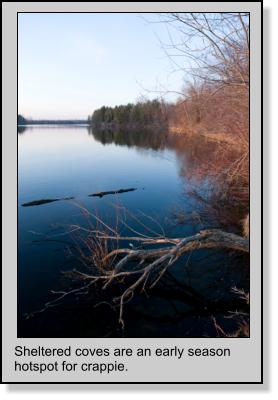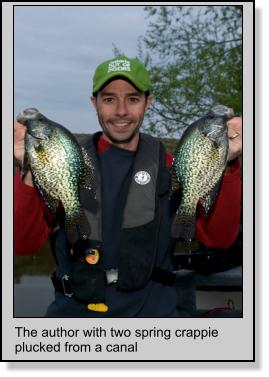|
 The
Three "C" s of Early Spring Crappie The
Three "C" s of Early Spring Crappie
By Tim Allard*
Immediately following ice crappie flock to protected, shallow water
areas. These zones are teeming with forage and crappie will feed
heartily for several weeks until the water’s warm enough for
spawning, which occurs between late spring and early summer.
Cracking the code on early-season crappie relies on the golden rule
of real-estate: location, location, location and when talking
paper-mouths in spring, this means fishing the Three Cs: coves,
creeks, and canals.
The Action's In The Sheltered, Shallows
Protected, sun-drenched, shallow-water areas that fit the
Three Cs are the VIP lounges of the spring paper-mouth party.
They’re comfortable, bustling with activity, and well-stocked with
hors-d’oeuvres. This is because they’re the first areas to warm
after ice-out. Spots on a northern side of a water system can be
particularly good as they receive the most sunshine, and are
protected from cold, north winds.
To go a step further, look for soft, dark-bottom areas. Like solar
panels these zones absorb the sun’s energy. Dirty water and decaying
plant materials can have a similar heat-soaking affect. Don’t get
put off by the muddy appearance; this is ground-zero for the feeding
festivities.
The abundant sunlight that coves, creeks and canals receive
increases their water temperature. This stimulates the food chain.
Plants grow and give off oxygen. Aquatic insects also get
rambunctious as fly hatches loom in the near future. In turn, the
boom in food and warmer water attracts baitfish. Crappie follow,
moving shallow to chow-down on invertebrates and minnows. The Three Cs all provide
a cornucopia of crappie edibles and when combined with the right
habitat they’re prime early-season spots.
to chow-down on invertebrates and minnows. The Three Cs all provide
a cornucopia of crappie edibles and when combined with the right
habitat they’re prime early-season spots.
Coves
I think of coves in a nautical sense when it comes to
spring crappie. These are sanctuaries hidden from winds and open
water. On blustery days these inlets are relatively tranquil. Not
all coves are created equal though when it comes to alluring
crappie.
Bullrushes and reeds boost a cove’s property value. The winter’s
snow and ice will have pushed over a lot of their stalks and the
result’s prime cover for crappie and a multitude of insects and
minnows. Add some sunken or standing wood and the area’s even
better. Healthy weeds are always good to find in coves. They attract
crappies and their forage alike.
Some coves feature an inflowing creek. The warm meltwaters and the
various foodstuff creeks carry appeal to panfish. Finding these two
components together often means you’ve located a prime fishing spot.
 Creeks Creeks
Still to slow-moving creek arms are other great spring-time
spots. Fallen or submerged, standing trees are crappie magnets. Look
for timber that’s outside of a creek’s main flow. There also tends
to be a lot of debris floating in creeks during spring. Expect
branches and other pieces of cover that collect this refuse to hold
fish.
Undercuts are another hotspot. Add some wood cover and you’ve hit
pay-dirt. The shelter and space of these two combined elements
appeals to crappie. Bullrush-lined inlets and pockets are also good
bets on creeks.
A word of warning, rain and subsequent increased water flow can
temporarily set back fishing quality. Once the system stabilizes,
creeks will crank out catches again.
Canals
Several different types of canals are paradise for crappie in
spring. One type is constructed to expand waterfront property and
create sheltered docking space for land owners. Another is a trench
created for agriculture irrigation. Bullrushes, stumps, healthy
weeds, and old dock pilings will all hold fish in these dug-outs.
Another type of canal is designed to connect lakes and feature
locks. These robust structures attract crappie in spring, before the
gateways begin their open-water operation. The stone walls of these
structures serve double duty. They block wind but also absorb the
sun and radiate its heat. Regardless of style, the best canals have
little or no flow, helping them quickly warm-up and retain their
temperate water.
The initial weeks of spring crappie fishing can be fantastic. To
boost your catches, position yourself on the prime real-estate of
the Three Cs and focus on woody and weedy cover. Give early-season
crappie fishing a go this season. It’s tough to beat the fun of
landing slabs in the warm spring sunshine. .
*Tim Allard of Ottawa, Ontario is a hard-water expert and
author-photographer of the newly released book, Ice Fishing: The
Ultimate Guide. For information visit:
www.helipress.com/product/ice-fishing-138.cfm
Editors & Publishers
T.J. & Monique Quesnel
|
The
Ontario Fishing Network
E-Magazine is
published 12 times a year on or near the beginning of every month. Our
magazine is geared to any angler who enjoys fishing of any type in the
wonderfully diverse province of Ontario. Editorial Submissions: We welcome query letters,
but assume no responsibility for unsolicited materials. Subscriptions: Subscriptions are FREE of charge
and delivered via email.
You can subscribe
HERE: Privacy Policy: Unlike other publications We
NEVER make our subscribers list (your email address) available to any
other companies. Advertising: If you are interested in advertising
please email us. Circulation - 13,000 email subscribers
© 2011 Due North
Marketing / Ontario Fishing Network / T.J. Quesnel. All rights
reserved. Reproduction of any material without prior written
permission strictly prohibited. |
|